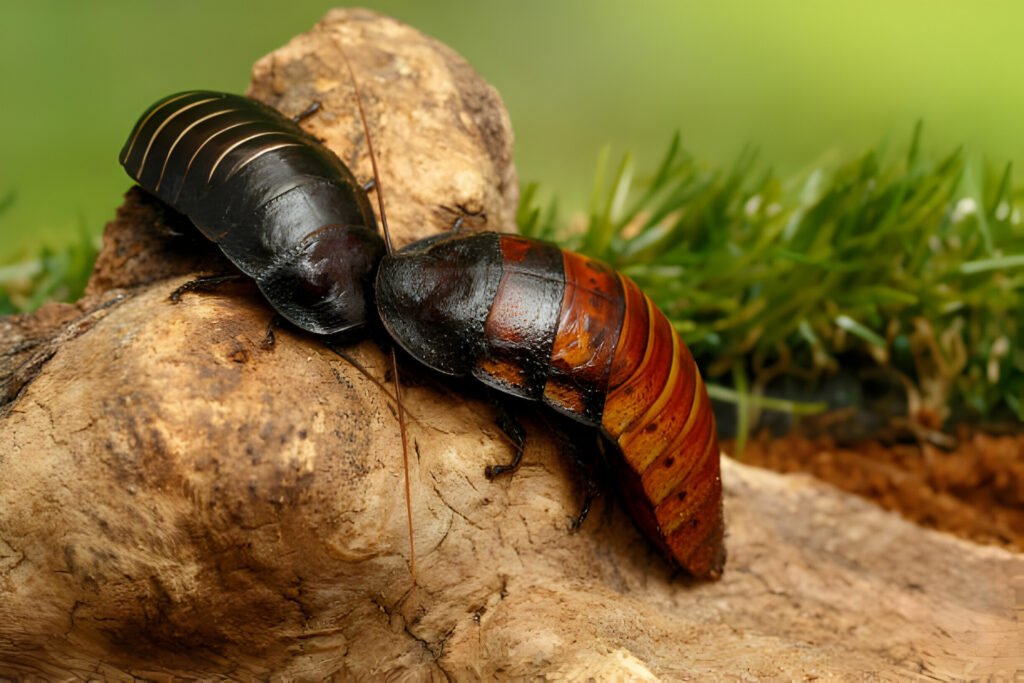Leopard geckos are a popular pet choice for reptile enthusiasts due to their docile nature and low-maintenance requirements. As with any pet, proper nutrition is crucial to their health and well-being. One question that often arises is whether leopard geckos can eat hissing cockroaches.
Hissing cockroaches are a common feeder insect for many reptiles, including bearded dragons and tarantulas. However, when it comes to leopard geckos, the answer is not so straightforward. While some leopard geckos may eat hissing cockroaches without issue, others may experience digestive problems or refuse to eat them altogether. In this article, we will explore the potential benefits and risks of feeding hissing cockroaches to leopard geckos and offer some tips for safely incorporating them into their diet.
Leopard Gecko Dietary Basics
Leopard geckos are insectivores, which means their diet consists mainly of insects. In the wild, they eat a variety of insects, including crickets, mealworms, and waxworms. However, in captivity, their diet must be carefully monitored to ensure they receive all the necessary nutrients.
Nutritional Requirements
Leopard geckos require a balanced diet that includes protein, fat, and vitamins. They need a high-protein diet to support their growth and development. Insects such as crickets and mealworms are good sources of protein for leopard geckos. They also need a moderate amount of fat to maintain their energy levels. Waxworms and butterworms are good sources of fat for leopard geckos.
Leopard geckos also require a variety of vitamins and minerals to stay healthy. Calcium is particularly important for leopard geckos, as it helps to maintain their bones and teeth. A lack of calcium can lead to metabolic bone disease, which can be fatal. To ensure they get enough calcium, leopard geckos should be fed a diet that includes calcium-rich insects, such as crickets that have been dusted with calcium powder.
Feeding Frequency
Leopard geckos should be fed once a day, or every other day, depending on their age and size. Juvenile leopard geckos require more food than adult leopard geckos, as they are still growing. Adult leopard geckos should be fed a moderate amount of food to maintain their weight.
It is important to monitor the amount of food your leopard gecko eats to prevent overfeeding. Overfeeding can lead to obesity, which can cause health problems such as fatty liver disease. It is also important to provide fresh water for your leopard gecko at all times.
Overall, leopard geckos require a balanced diet that includes a variety of insects and provides all the necessary nutrients. By following these dietary basics, you can help ensure your leopard gecko stays healthy and happy.
Hissing Cockroaches as Feed

When it comes to feeding leopard geckos, there are a variety of options available. One of these options is hissing cockroaches. While not a traditional food source for leopard geckos, hissing cockroaches can provide a nutritious meal for your pet.
Nutritional Profile
Hissing cockroaches are high in protein, making them a good source of nutrition for leopard geckos. They also contain essential amino acids, vitamins, and minerals that are important for your pet’s health. However, it is important to note that hissing cockroaches should not be the sole source of nutrition for your leopard gecko. They should be fed in combination with other foods such as crickets, mealworms, and waxworms.
Risks and Considerations
While hissing cockroaches can provide a nutritious meal for your leopard gecko, there are some risks and considerations to keep in mind. First, hissing cockroaches are larger than other feeder insects, which means they may not be suitable for smaller leopard geckos. Second, hissing cockroaches are known to emit a foul odor when threatened or disturbed, which can be unpleasant for both you and your pet. Finally, hissing cockroaches can be more expensive than other feeder insects, which may not be feasible for all leopard gecko owners.
In conclusion, hissing cockroaches can be a nutritious food source for leopard geckos when fed in combination with other foods. However, it is important to consider the risks and limitations before incorporating them into your pet’s diet. As always, consult with a veterinarian or reptile specialist for guidance on the best diet for your leopard gecko.
Preparing Cockroaches for Feeding

When feeding our leopard geckos, it’s important to prepare their food properly to ensure they receive the necessary nutrients. Hissing cockroaches are a great option for leopard geckos, but we must prepare them before feeding.
Gut Loading
Gut loading is the process of feeding the insects a nutritious diet before they are fed to our leopard geckos. This ensures that the insects are packed with the necessary nutrients that our geckos need. We recommend feeding the cockroaches a diet of fresh fruits and vegetables for at least 24 hours before feeding them to our geckos.
Size Selection
The size of the cockroach we feed our leopard geckos is important. We must ensure that the cockroach is not too big for our gecko to consume, but also not too small that it doesn’t provide enough nutrients. As a general rule, the size of the cockroach should not be larger than the width of our gecko’s head.
To summarize, preparing hissing cockroaches for feeding requires gut loading them with fresh fruits and vegetables for at least 24 hours and selecting an appropriate size for our leopard geckos. By following these steps, we can provide our geckos with a nutritious and tasty meal.
Feeding Technique
When it comes to feeding leopard geckos, it is essential to ensure that the prey is safe and healthy for them to consume. In this section, we will discuss the feeding technique for leopard geckos, specifically when feeding them hissing cockroaches.
Live Prey Handling
Live prey handling is a crucial aspect of feeding leopard geckos. It is essential to ensure that the prey is healthy and free from any diseases or parasites. Before feeding your leopard gecko hissing cockroaches, it is recommended to quarantine them for a few days to ensure that they are healthy.
When handling live prey, it is important to use clean hands and avoid touching the prey with bare hands. It is recommended to use feeding tongs to handle the prey and avoid any potential injuries to both the prey and the leopard gecko.
Feeding Tongs Usage
Feeding tongs are an essential tool when it comes to feeding leopard geckos. They allow us to handle the prey without any risk of injury and ensure that the leopard gecko can safely consume the prey.
When using feeding tongs, it is important to ensure that they are clean and free from any bacteria or parasites. It is recommended to disinfect the tongs after each use with a reptile-safe disinfectant.
In conclusion, feeding leopard geckos hissing cockroaches requires proper handling techniques and the use of feeding tongs. By following these guidelines, we can ensure that our leopard geckos are healthy and safe while consuming their prey.
Monitoring Gecko Health
When keeping leopard geckos as pets, it is important to monitor their health regularly. This involves observing their behavior, appetite, and physical appearance. In this section, we will discuss two important aspects of monitoring gecko health: digestive health and weight tracking.
Digestive Health
Leopard geckos are known to have sensitive digestive systems, and feeding them inappropriate foods can lead to health problems. While hissing cockroaches are a potential food source for leopard geckos, it is important to monitor their digestive health after feeding them. Signs of digestive problems may include lack of appetite, diarrhea, or constipation.
To ensure good digestive health, we recommend feeding leopard geckos a varied diet that includes appropriate insects, such as crickets, mealworms, and waxworms. It is also important to provide a calcium supplement to prevent metabolic bone disease.
Weight Tracking
Another important aspect of monitoring gecko health is tracking their weight. A sudden weight loss or gain can indicate health problems. We recommend weighing leopard geckos regularly, using a digital scale that measures in grams.
To track weight changes, we suggest keeping a record of the gecko’s weight in a spreadsheet or notebook. This can help identify any trends or sudden changes in weight, which can be useful in detecting health issues early on.
In summary, monitoring the digestive health and weight of leopard geckos is crucial for their overall wellbeing. By providing a varied diet and tracking their weight regularly, we can help ensure that our geckos stay healthy and happy.
Alternatives to Hissing Cockroaches

If you’re looking for an alternative to feeding your leopard gecko hissing cockroaches, there are a few options available. Here are some live prey and commercial diet options to consider.
Commercial Diets
There are a variety of commercial diets available for leopard geckos, including meal replacement powders and pellets. These diets are formulated to provide a balanced diet for your gecko and can be a convenient alternative to live prey. However, it’s important to note that some geckos may not readily accept these diets, and they should not be the sole source of nutrition for your pet.
Other Live Prey Options
There are a variety of live prey options that can be offered to leopard geckos. Some popular options include crickets, mealworms, and waxworms. These insects can be purchased at most pet stores and are relatively easy to care for. It’s important to ensure that the insects are gut-loaded (fed a nutritious diet) before feeding them to your gecko.
In addition to insects, some geckos may also enjoy small amounts of pinkie mice or other small rodents. However, it’s important to note that these should be offered sparingly and should not make up a significant portion of your gecko’s diet.
Overall, there are a variety of options available for feeding your leopard gecko. It’s important to research and consider the nutritional needs of your pet before making any changes to their diet.
Frequently Asked Questions
Are hissing cockroaches safe as food for leopard geckos?
Yes, hissing cockroaches are safe for leopard geckos to eat. However, it is important to ensure that the hissing cockroaches are captive-bred and not wild-caught, as wild-caught insects may carry parasites or diseases that can harm your leopard gecko.
What nutritional value do hissing cockroaches provide to leopard geckos?
Hissing cockroaches are a good source of protein and fat for leopard geckos. They also contain some vitamins and minerals that are important for your gecko’s health, such as calcium and phosphorus.
How should hissing cockroaches be prepared for leopard geckos?
Hissing cockroaches should be gut-loaded with nutritious food before being fed to your leopard gecko. This means feeding them a diet of fruits, vegetables, and high-quality insect food for at least 24 hours before feeding them to your gecko. You can also dust the hissing cockroaches with a calcium and vitamin supplement before feeding them to your gecko.
What size hissing cockroach is appropriate for leopard geckos to consume?
Leopard geckos can eat hissing cockroaches that are smaller than the width of their head. It is important to choose an appropriate size of hissing cockroach to prevent choking or other digestive problems.
How often can leopard geckos be fed hissing cockroaches?
Hissing cockroaches can be fed to leopard geckos as a treat once or twice a week. It is important to vary your gecko’s diet and offer a variety of other insects and foods to ensure they are getting a balanced diet.
Are there any risks associated with feeding hissing cockroaches to leopard geckos?
While hissing cockroaches are generally safe for leopard geckos to eat, there is a risk of choking or other digestive problems if the cockroaches are too large or not prepared properly. It is important to supervise your gecko while they are eating and provide appropriately sized insects that have been gut-loaded and dusted with supplements.





